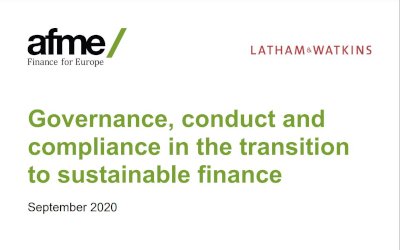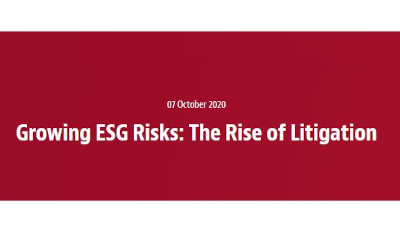

by Eleanor Leach | Oct 19, 2020 | Non-financial reporting, Purpose & business model

by Eleanor Leach | Oct 15, 2020 | Fiduciary duty, Risk management
RE-Source is the European Platform for corporate renewable energy sourcing, founded by WBCSD, RE100, SolarPower Europe and WindEurope.
– WBCSD has developed business cases for low-carbon energy solutions to help energy users decide which technologies are most suitable for their decarbonization needs. They include direct electrification solutions such as heat pumps, electric vehicles and shore-to-ship power; renewable solutions such as concentrated solar heat and solar cooling systems; and solutions to improve energy efficiency such as building energy management systems.
– WBCSD has published several reports on corporate renewable purchase power agreements (PPAs). These reports guide companies in the process of procuring renewable power via PPAs, highlight innovations in PPA structures and explain the application of relevant accounting principles.
– Improveinvestor confidence and attract investment from new sources
– The International Renewable Energy Agency (IRENA) regularly publishes guides aimed at corporations and energy users looking to source renewables. Publications include the global view and in-depth studies on certain sectors and renewable technologies.
– IRENA, Corporate Sourcing of Renewable Energy: Market and Industry Trends
– IRENA, Global Renewables Outlook: Energy transformation 2050
– International Energy Agency, Renewable Energy For Industry
– International Energy Agency, Tracking Clean Energy Progress
– Energy Transitions Commission, Mission Possible
Process emissions are emissions from physical or chemical processes such as CO2 from the calcination step in cement manufacturing, CO2 from catalytic cracking in petrochemical processing and perfluorocarbon (PFC) emissions from aluminum smelting.
Other sustainability targets may be set for environmental performance indicators relating to water, waste and pollution.
A renewable energy target commits a company to using energy from renewable sources. Typically, this will be an objective to source a certain percentage of electricity from renewable sources by a stated year, or specifically related to areas of your business.
While renewable energy targets usually cover electricity consumption, they can cover other energy inputs, including those used for heating, cooling, production processes and transport.
RE100 is a collaborative, global initiative run by The Climate Group and CDP whereby companies publicly commit to sourcing 100 percent of their global electricity consumption from renewable sources by a specified year.
Setting a target to reduce the amount of energy used – in absolute terms or relative to an appropriate indicator of output for your business – helps your company to show energy performance improvements over time.
Companies who are looking to decouple growth from an increase in energy consumption will set an energy intensity or energy productivity target. This type of target measures energy consumption relative to economic output, or a more specific operational indicator, such as hours worked, or units produced.
The UN Sustainable Development Goal 7.3 includes a commitment to double the global rate of improvements in energy efficiency by 2030 against a 2010 baseline. Companies should evaluate whether they can align with this ambition.
The EP100 initiative brings together a group of companies which commit to use energy more productively. Members of the initiative choose among three commitments: Doubling the economic output from every unit of energy it consumes globally within 25 years; implementing a smart energy management system globally and committing to an energy productivity target; or owning, occupying or developing buildings that operate at net zero carbon by 2030.
The Science Based Targets initiative (SBTi) is a joint initiative by CDP, the UN Global Compact, WRI and WWF. It produces methodologies and guidance to set GHG emission reduction targets and validates company targets.
Setting SBTs allow companies to:
Science-based targets within the SBTi must cover company-wide Scope 1 and 2 emissions, and if Scope 3 emissions are greater than 40 percent of a company’s total emissions, a target must be set for two-thirds of Scope 3 emissions. Targets must span a time period of 5 – 15 years from the year the target is announced. The SBTi does not allow the use of carbon offsets to achieve a science-based target.
A net zero carbon target describes the aim of a company to become carbon neutral by balancing any residual GHG emissions and other relevant effects on the climate generated by the company across its value chain with anthropogenic removals. This differs to a zero carbon target as it allows the use of carbon offsets.
The use of offsets to achieve net zero carbon targets should not replace efforts to mitigate GHG emissions. Companies should develop a long-term pathway for GHG emissions reductions and only use carbon offsets when alternative GHG emission reduction options are not available.
It’s important to define the boundary of GHG emissions that a net zero carbon target covers. Best practice is to cover 100 percent of a company’s Scope 1, 2 and 3 emissions.
CDP climate change questionnaire
Register with CDP to get access to publicly available information from respondents to CDP’s Climate Change questionnaire. This includes information on the energy and carbon targets they have set.
The GHG Protocol’s standards for GHG accounting divides GHG emissions into three scopes:
Scope 3: Other indirect GHG emissions which are the consequence of the activities of the company, but occur from sources not owned or controlled by the company. E.g. emissions related to purchased goods and services, and emissions linked to the use of sold products and services.
The central aim of the Paris Agreement is to keep global temperature rise well below 2°C above pre-industrial levels, and to pursue efforts to limit this temperature increase to 1.5°C. It was adopted in December 2015 by the 21st Conference of the Parties (COP21) of the United Nations Framework Convention on Climate Change (UNFCCC).
The UNFCCC is an intergovernmental environmental treaty developed to address climate change. It has 197 parties, including all United Nations member states and some non-member states. As of February 2019, 195 UNFCCC members have signed the Paris Agreement and 185 have become party to it.
For the purpose of these guidelines, low-carbon refers to greenhouse gas (GHG) emissions from the generation or use of energy. A low-carbon energy solution produces or consumes energy resources with close-to-zero GHG emissions. A low-carbon company is a company that uses energy sources that have a minimal or net-zero output of GHG emissions.
Generally, circularity moves away from the traditional “take-make dispose” economic model to one that is regenerative by design. The goal is to retain as much value as possible from resources, products, parts and materials to create a system that allows for long life, optimal reuse, refurbishment, remanufacturing and recycling.
For the energy system, circularity means designing processes and solutions to extract, convert and use energy that maximizes the efficient use of resources. This includes not only the use of renewable energy resources, but also by-products of other processes – such as waste heat, flue gases, biomass, and municipal and industrial solid waste – as energy inputs. It’s also about optimizing the end use of energy, e.g. through controls, demand response, energy storage and energy efficient appliances or processes.
Circularity in the energy system also consists of designing and manufacturing assets to be reused, repaired, refurbished, remanufactured and recycled, minimizing idle time and environmental impacts across an asset’s life cycle.
Bioenergy refers to renewable energy derived from biological sources, such as (waste) wood, crop residues and manure. While bioenergy can be a low-carbon alternative, it requires responsible and sustainable sourcing to prevent potential negative impacts, such as demand leading to deforestation or reducing land availability for food production.
Hydrogen combustion generates zero emissions at the point of use – just water. Hydrogen production, however, can involve fossil fuels, such as natural gas, or require significant quantities of potentially carbon-intensive electricity. Green hydrogen refers to hydrogen made from the electrolysis of water, powered by zero-carbon electricity only.
Companies can use natural gas – in the short to medium term – to decarbonize energy use and align with a 1.5°C emissions trajectory, if it replaces more carbon-intensive sources such as coal and oil, and if fully decarbonized solutions are unavailable or economically unviable at present. In the medium and long term, electrofuels, such as green hydrogen, are expected to displace the fossil fuels currently used for high temperature heat.
A PPA is a contract between the corporate buyer (off-taker) and the power producer (developer, independent power producer, investor) to purchase electricity at pre-agreed prices for pre-agreed periods. The contract contains the commercial terms of the electricity sale: length, delivery point/date, volume and price. The power producer can supply the electricity via existing renewable energy assets or new build projects.
For further information, refer to WBCSD’s resources on PPAs.
Scope 1 emissions are direct emissions from sources directly owned or controlled by the company, for example, natural gas used in boilers or fuel used in owned or leased vehicles.
Scope 2 emissions are indirect emissions from the generation of purchased energy, for example power, heat or steam.
Scope 3 emissions are all indirect emissions not included in Scope 2 that occur in the company’s value chain, from upstream and downstream activities.
Energy Transitions Commission, Mission Possible
Low-carbon energy refers to greenhouse gas (GHG) emissions from the generation or use of energy. A low-carbon energy solution produces or consumes energy resources with close-to-zero GHG emissions.
Recent Comments